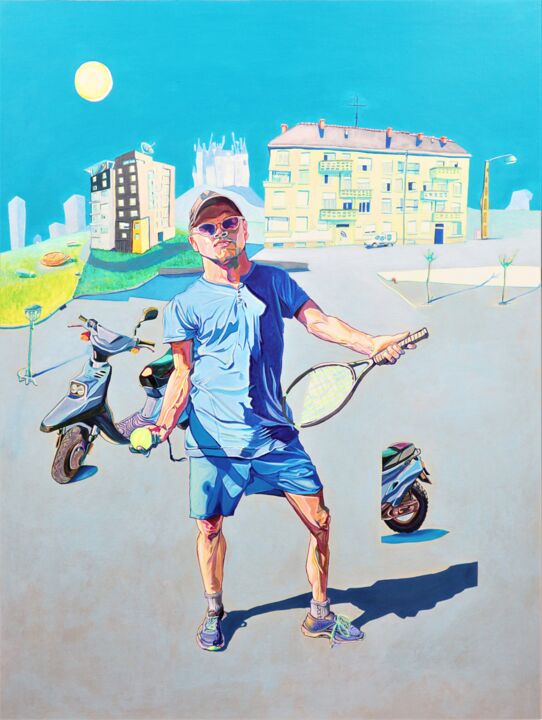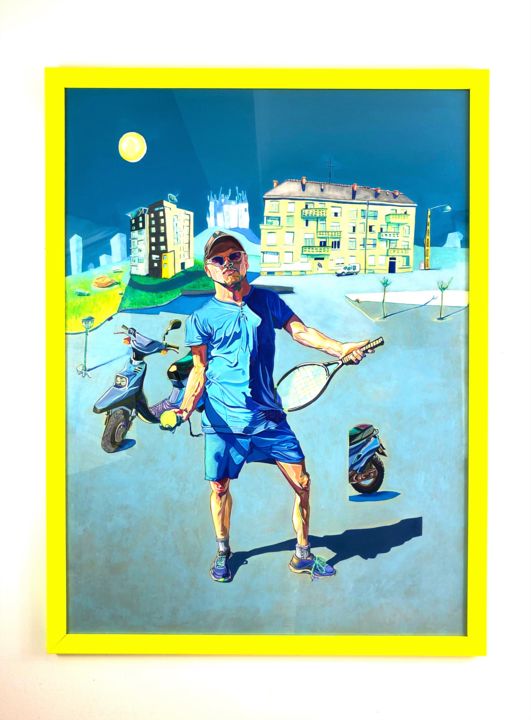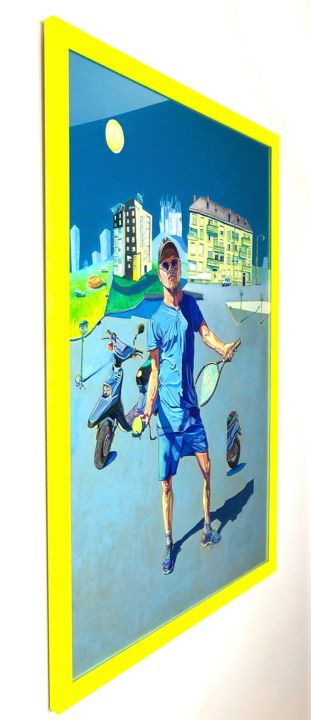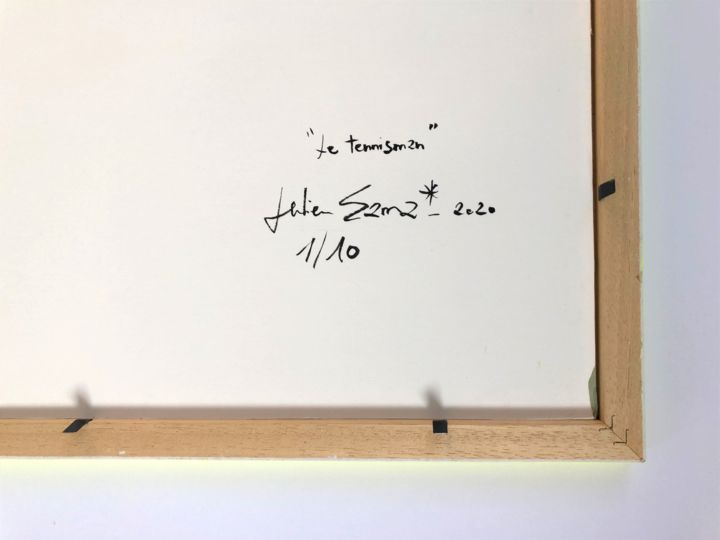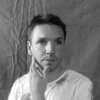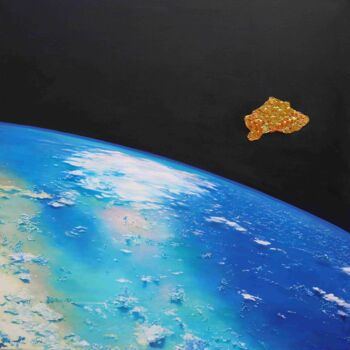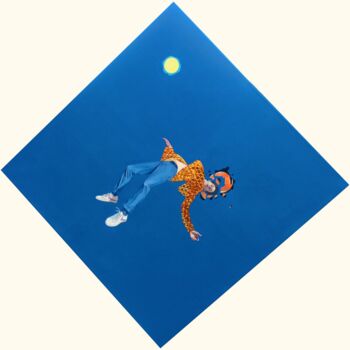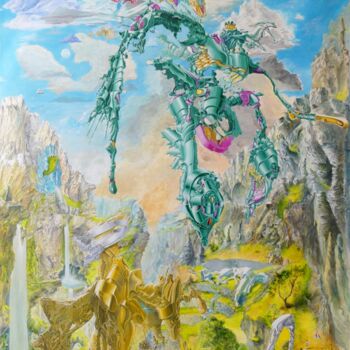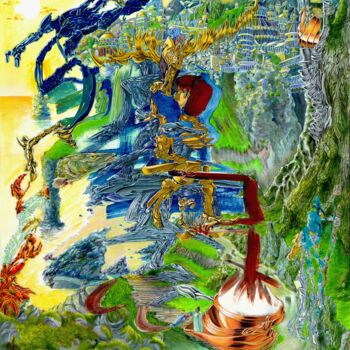le tennisman (2020) Painting by Julien Sama
Sold
See more from Julien SamaThe artist offers works on commission
Did you miss the opportunity to buy this work? Good news: the artist can also create a custom work, just for you!
Sold by Julien Sama
This image is available for download with a licence
Sold by Julien Sama
-
Original Artwork (One Of A Kind)
Painting,
Acrylic
on Paper
- Dimensions Height 29.5in, Width 21.7in
- Framing This artwork is not framed
- Categories Paintings under $1,000 Figurative Tennis
Elle représente un homme en tenue de sport posant fièrement devant son scooter. Sa position, le drapé de ses vêtements font sciemment référence au portrait des rois d'antan et à l'histoire de l'art (on peut penser ici au bleu obtenu autrefois grâce au lapis-lazuli). Les objets signifiant le pouvoir royal sont ici complètement détournés : l'orbe devient une balle de tennis, le sceptre : une raquette. Cette peinture cherche à dire que la noblesse ne se trouve plus chez l'élite qui s'affirme comme tel, mais bel et bien chez ceux d'en bas.
La perspective et les proportions sont ici malmenées sans que l'on sen rende vraiment compte. Des éléments semblent surgir de nulle-part, mais l'ensemble garde pourtant un aspect réaliste. Par ces coupes franches dans les formes, les vibrations crées par leur ondulation, mais aussi en appliquant une lumière forte, j'essaie de trouver une autre réalité. De montrer que le réalisme n'est finalement qu'une dérive qui tire sa source d'une envie de réduire les choses à leur surface et non à leur essence.
Je m'évertue grâce à cette manière de peindre, à montrer des procédés conceptuels inhérents à notre cerveau. Par exemple, lorsque je fixe un endroit celui si devient plus "gros" mentalement, car le cerveau s'attarde sur tous ses détails. Mais alors, ce qui l'entoure perd de sa valeur, ou en tout cas de son réalisme. C'est pourquoi je mélange ici réalisme et dessin presque enfantin (le château en fond est le premier dessin significatif que j'ai réalisé en maternelle, qui représente pour moi le début de ma quête artistique). Je mélange aussi beaucoup réalité et mythologie personnel, toujours dans l'optique de retranscrire mon monde intérieur.
Les différents bâtiments sont des lieux que j'ai côtoyé et qui n'existent plus, la peinture me permet alors de rendre ses "fantômes" de nouveau vivant. La luminosité tend vers le bleu, car à l'origine je voulais retranscrire une sensation. Vous savez celle que l'on a tous vécu, lorsque le soleil est haut, que vous l'observez les paupières fermées. Après un certain temps, lorsque vous rouvrez les yeux sur votre environnement, tout vous semble bleuté. J'ai donc essayé, mais j'ai raté...
This painting is the first of a series of ten.
It depicts a man in sportswear proudly posing in front of his scooter. His position and the draping of his clothes deliberately refer to the portrait of the kings of yesteryear and to the history of art (here we can think of the blue obtained in the past thanks to lapis lazuli). The objects signifying royal power are completely misused here: the orb becomes a tennis ball, the sceptre a racket. This painting seeks to say that nobility is no longer to be found among the elite who assert themselves as such, but among those below.
Perspective and proportions are mishandled here without any real sense of proportion. Elements seem to appear out of nowhere, but the whole thing still looks realistic. Through these sharp cuts in the forms, the vibrations created by their undulation, but also by applying strong light, I try to find another reality. To show that realism is in the end only a drift that comes from a desire to reduce things to their surface and not to their essence.
Through this way of painting, I try to show conceptual processes inherent to our brain. For example, when I stare at a place, it becomes mentally "bigger" because the brain lingers on all its details. But then, what surrounds it loses its value, or at least its realism. This is why I mix here realism and almost childish drawing (the castle in the background is the first significant drawing I made in kindergarten, which represents for me the beginning of my artistic quest). I also mix a lot of reality and personal mythology, always with the aim of transcribing my inner world.
The different buildings are places that I have been in contact with and that no longer exist. Painting then allows me to make these "ghosts" come alive again. The luminosity tends towards blue, because originally I wanted to retranscribe a sensation. You know the one we have all experienced, when the sun is high, when you look at it with your eyelids closed. After a while, when you reopen your eyes on your surroundings, everything seems bluish. So I tried, but I failed...
Related themes
Young artist graduated from the fine arts of Bordeaux, I mainly use painting and drawing as a means of experimentation and expression. But nothing prevents me from varying the mediums, from sculpture to video if the need arises. My main areas of research are science, mainly astrophysics and biology, but also philosophy, history, literature and spirituality.
I wonder about the notion of freedom and truth in a hyper-connected and hyper-controlled universe. But the questions that inspire me the most are metaphysical in nature and focus on the invisible. My work is an inner quest which must accommodate its interaction with the materiality of the world. With these concerns in mind, my work is inspired by the so-called "borderless universe" theory of cosmologist Stephen Hawking. Who sums it up as follows:
"Suppose the beginning of the universe is the Earth's south pole, with the degrees of latitude playing the role of time. As we go north, the circles of constant latitude that represent the size of the universe go The Universe would start off as a point on the South Pole, except that the South Pole looks like any other point. It makes no sense to ask what preexisted the Universe because it there is nothing south of the south pole. " (Stephen Hawking - Leonard Mlodinow: "Is there a great architect in the Universe?")
So each of my creations takes a shape, an object, a character etc ... from a previously executed painting. By this system, each canvas is a window open to another, thereby giving the viewer the impression of always projecting himself forward without being able to finally designate a beginning and an end. In addition to allowing a link between each of my creations and creating a personal microcosm, this process allows me to integrate my present concerns (and therefore evolving) in each new creation. Thanks to this creative process, my art allows itself great freedom as much in terms of the mediums used (painting, sculpture, drawing, video, photo ...) as of the subjects addressed (see the paragraph above).
I took part in various group exhibitions in Bordeaux, notably at the Pola factory and in Offenbach in Germany.Envoyer des commentairesHistoriqueEnregistréCommunauté
-
Nationality:
FRANCE

- Date of birth : 1987
- Artistic domains: Works by professional artists,
- Groups: Professional Artist Contemporary French Artists

